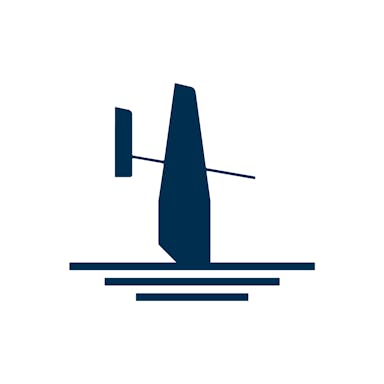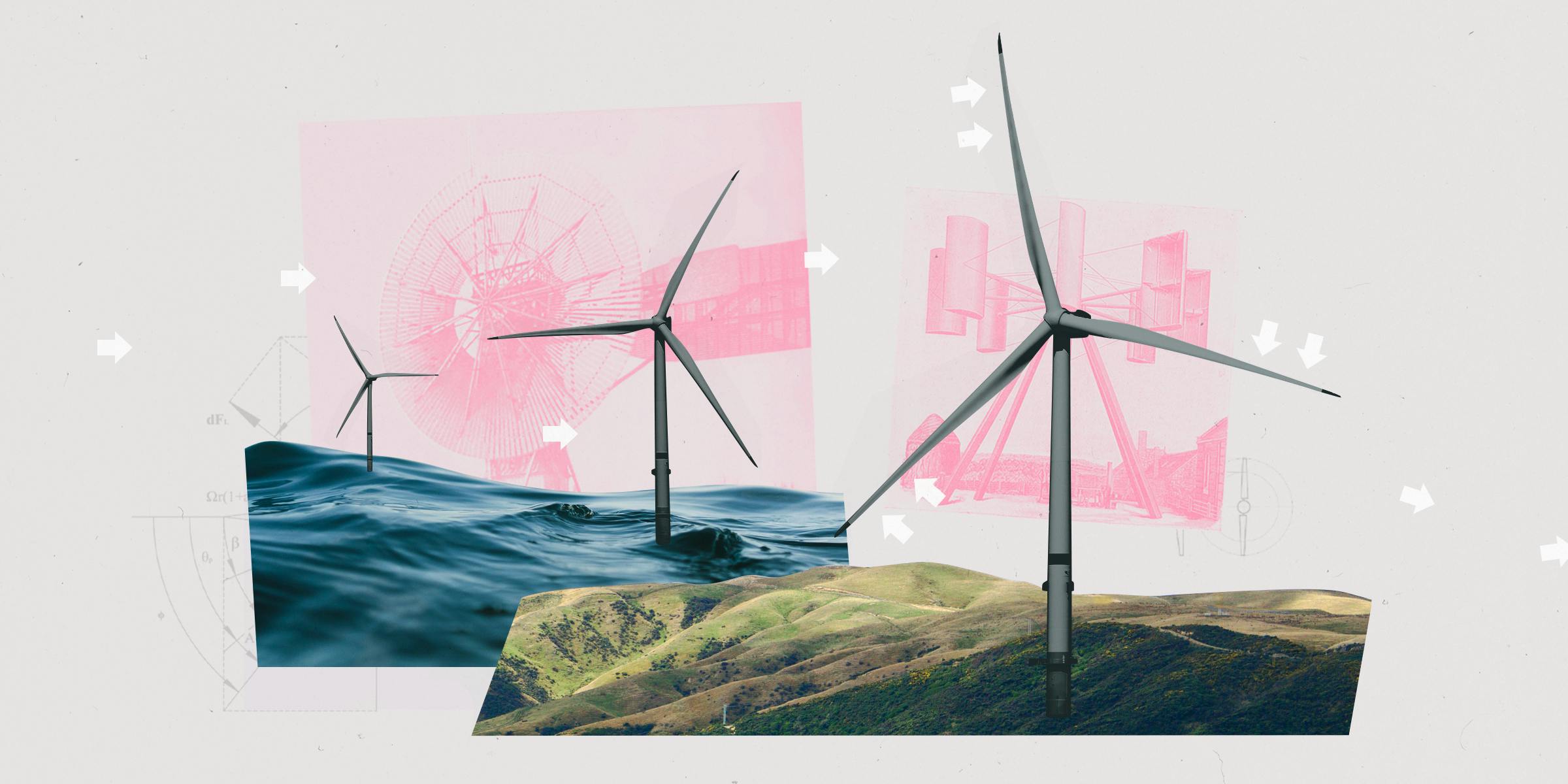Thesis
The ocean is integral to human life, capturing carbon from the atmosphere, supporting over 3.3 million jobs in the United States, and contributing to the hydrologic cycle. The United Nations calls the ocean the “world’s greatest ally against climate change.” In 2024, the science branch of the US Department of Commerce (NOAA) requested $81.4 million to support ocean mapping efforts. At the same time, over 80% of the ocean remains unexplored, and only 23% of the ocean is fully mapped. The founder and CEO of Saildrone has said, “We know more about the Moon and Mars than we do about our own planet.” This has left a gap in national security and addressing climate change, which rely on high-quality data to inform decisions.
The government is investing more in the ocean for national security purposes. In 2023, the presidential budget request of $842 billion included $230.8 million for the Navy and Marine Corps, a 4.1% increase from the prior year and 30% more than the Army budget. This reflects the shift from decades of war in the Middle East to emerging threats in the Indo-Pacific. Following the Russian invasion of Ukraine, the US has pledged over $43 billion to secure Ukraine’s sovereignty in 2024.
As conflict increases, low-range armored vehicles are no longer effective against adversaries across the ocean. Long-range vehicles that can gather a vast range of intelligence and information can enable the country to take advantage of the ocean to build coastal infrastructure or identify enemy locations. For example, in 2023, the US deployed a fleet of Unmanned Surface Vehicles (USVs) to Ukraine in response to Russia’s invasion. Despite growing interest in naval power, the United States had 4K operational battle tanks yet fewer than 300 deployable sea vessels in 2023.
Beyond military dynamics, the ocean directly influences climate change. The boundary between the sea and air is decreasing, making it easier for changes in ocean temperature to interact with the atmosphere. In 2023, global surface temperature had risen by 2° F since 1850 and has been increasing three times as fast. Despite the maritime industry accounting for 3% of the worldwide greenhouse gas emissions, countries have little observability over their oceans to address this issue. Increased regulatory pressure from the International Maritime Organization (IMO) to decarbonize the oceans is increasing the barrier to entry for new companies looking to build solutions in the field. Increased public concern over climate change and the lack of companies addressing climate change incentivizes the government to invest more money into information collection from the seas to understand the source of the issues.
Saildrone is developing ocean drones to understand the seafloor by collecting high-resolution data based on wave patterns and sensor data. The goal is to reach areas of the sea that are uninhabitable to humans, which can be used to understand climate conditions, suitable regions for coastal infrastructure, and illegal fishing practices. Ultimately, Saildrone aims to support the national interest by providing visibility over the ocean to take advantage of its resources.
Saildrone designs, manufactures, and operates autonomous wind‑ and solar‑powered USVs, known as saildrones. These autonomous vessels carry science‑grade and defense‑grade sensor suites to collect high‑resolution oceanographic, meteorological, and security data. From sailing through category 4 hurricanes to circumnavigating Antarctica, Saildrone’s vessels are able to operate autonomously for up to a year. The company’s goal is to offer persistent, low‑cost, real‑time intelligence, surveillance, and reconnaissance in even the world’s harshest maritime environments.
Founding Story

Source: Bloomberg
Saildrone was founded in 2012 by Richard Jenkins, an engineer originally from the UK. He grew up in a small village near Southampton, where he was exposed to sea life early. He began designing boats and sailing at age 10. His early fascination with the ocean turned into large-scale expeditions like circumnavigating the Atlantic.
He studied Mechanical Engineering at Imperial College London in 1998 before founding Proteus Speed Ltd, which turned into a passion project called “Windjet”. For the next ten years, Jenkins set himself on breaking the land speed record for a wind-powered vehicle. Through Proteus, he spent a decade refining the physics of the land yacht in Ivanpah, which was a dry lake region he used for testing. In 2009, the yacht nicknamed “Greenbird” broke the world record at 126.1 mph. Greenbird became the model for the design of Saildrone. Before closing the company, he renamed the project “Ecotricity Greenbird” as a nod to the clean energy fuels he used to power the vessel.
After nearly a decade of designing what would become Saildrone, Jenkins moved to San Francisco. Here, he would build a new patented company called Saildrone. The idea of the Saildrone is twofold. First, it aims to capture highly detailed images of the ocean floor while minimizing human intervention. Second, it aims to do so with the least energy possible. At its core, Jenkins wanted to live out the Magellan vision of circumnavigating the globe with autonomous fleets of sailboats. In 2022, Jenkins was awarded the Albert A. Michelson Award by the Navy League of the United States, recognizing his “scientific achievement” and Saildrone’s contributions to the American Navy.
Product
The Saildrone
Saildrone is, at its core, a data company. Its primary product is the Saildrone, an unmanned surface vehicle (USV). However, the vessel itself is not commercially sold to customers. Instead, it is used to collect high-resolution data on the ocean, which is then visualized through a software control interface and bought by research institutes. Customers pay for operating missions and additional payloads like depth sensors to collect more data.
Saildrone focuses on data that helps determine “central climate variables” like water temperature and flux rates to characterize the sea. Several design decisions supported this effort. Saildrones are aerodynamic, with a rigid wing that produces thrust in the same way that planes produce lift. It can also carry a suite of 20 scientific sensors to increase the resolution of data.
The vessel is also designed to withstand extreme weather and perform tasks that humans cannot. In 2021, a saildrone sailed into a category four hurricane to better understand violent storms. This capability is powered by two design decisions: sustainability and autonomy.
Saildrone made major efforts to reduce carbon emissions. This supported efforts to harness continuous energy sources from the environment instead of relying on fixed energy sources like fuel. The vessels themselves are powered only by solar and wind energy. A 23-foot Explorer model converts solar and wind energy to power, which it then uses to power full year-long missions. This supports clean and efficient energy consumption while increasing the vessel's longevity at sea. Additionally, the vessel is entirely built with carbon composite material, which is lighter and resistant to wear. In 2024, Saildrone’s USVs were able to reduce carbon emissions by 99.9% compared to traditional research vessels.
Autonomy supports fleets that do not require additional human support, which can be costly. Together, Saildrone fleets have traveled over 1 million nautical miles as of 2023. This is powered by long-range and high-bandwidth communication systems that allow human operators to monitor the Saildrone’s movement at each mission step. Signals can reach 11K meters, enabling visibility of any vessel, no matter if it’s on the surface or submerged underwater.
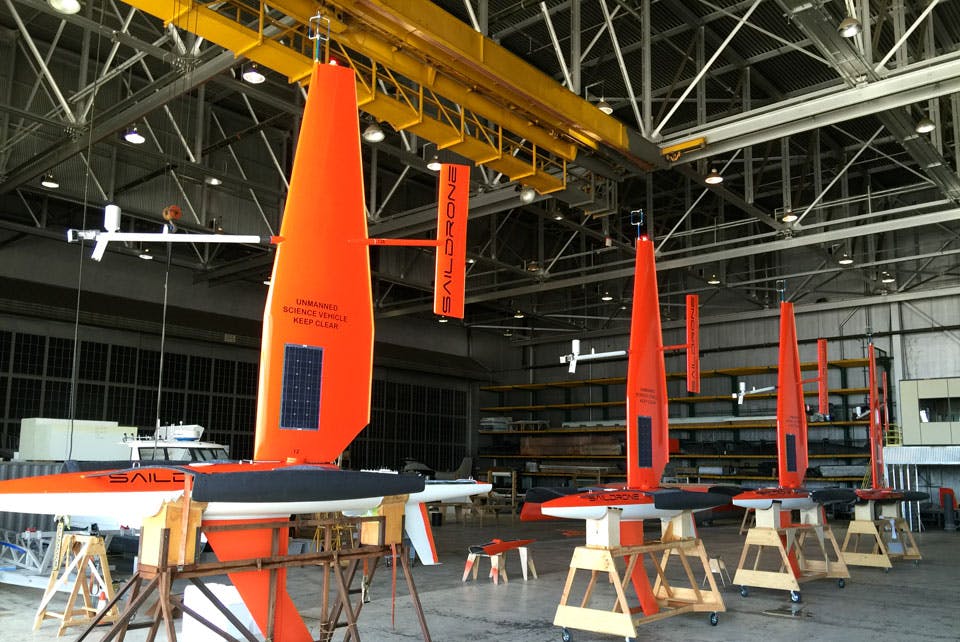
Source: NOAA
As of 2024, the company had 100 saildrones manufactured with plans to deploy a fleet of 1K drones over time. The vessels are divided into three different offerings based on the scale of the mission:
Explorer: This is the first vessel introduced in 2015. It stands as the smallest vessel, measuring 23 feet in length. It’s designed for long-duration missions and collecting a broad range of scientific data, such as hurricane and fish monitoring. The vehicle runs solely on solar and wind power, making its carbon footprint much lower than traditional research vehicles.
Surveyor: Introduced in 2021, this is the largest vessel at 65 feet long and was primarily engineered for deep-water ocean mapping. It supports missions that require high-resolution seafloor mapping and collecting large volumes of data. In addition to solar and wind power, it’s also equipped with a diesel generator for extended missions.
Voyager: This is the final installation in the set of saildrones; a mid-sized vessel introduced in 2023. After primarily supporting research missions for the past decade, the Saildrone team decided to extend capabilities to near-shore ocean mapping and maritime security for the US government. The Voyager was designed for reconnaissance missions, including surveillance, intelligence-gathering, border security, and uncovering illegal fishing. Similar to the Explorer and Surveyor, the Voyager is also primarily powered by wind and solar energy. An additional electric propulsion system is included to support low-wind conditions common in near-shore environments. In March 2025, the company announced Voyager was now capable of operating in GPS-denied environments.
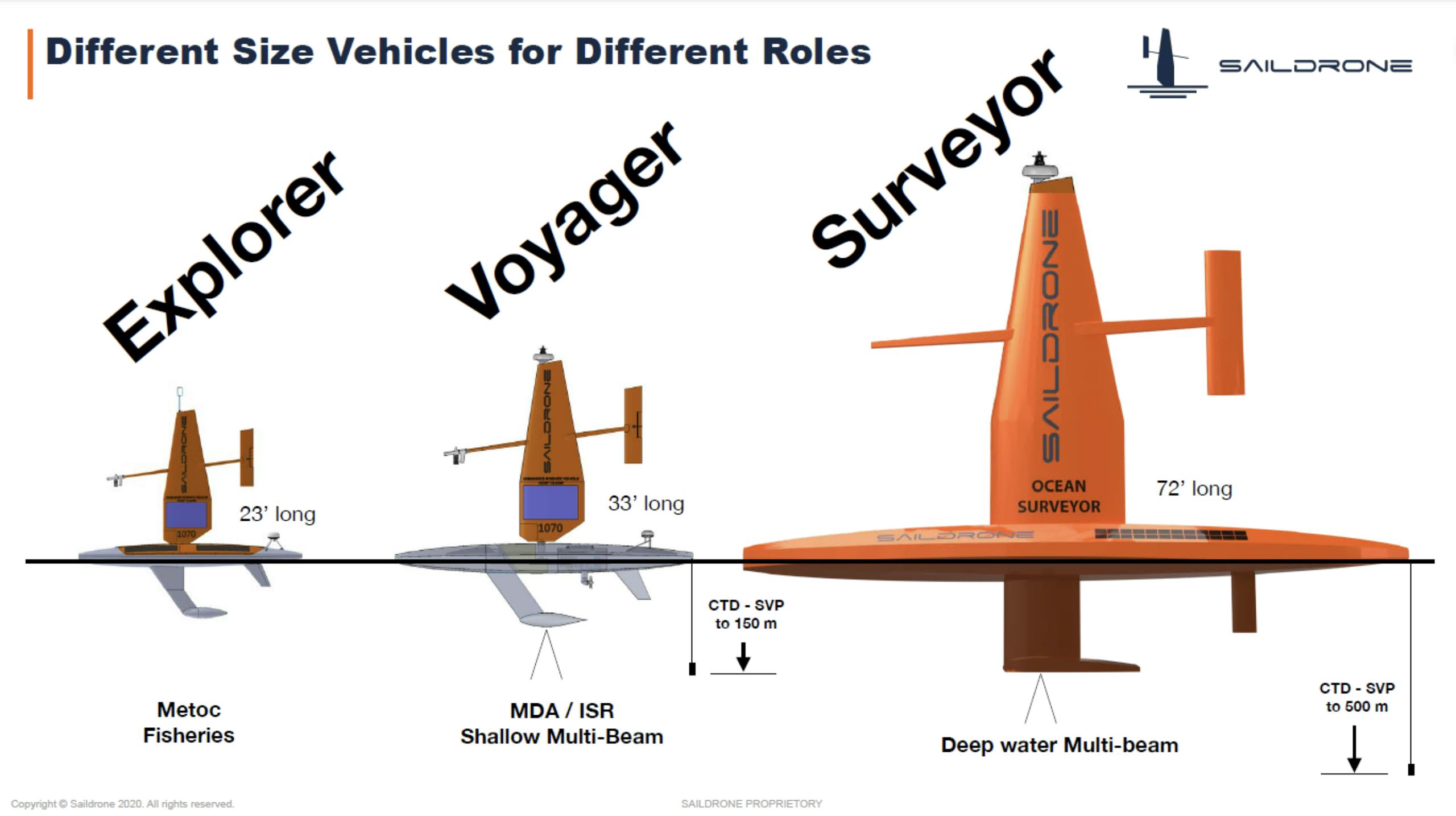
Source: Saildrone
Data Analysis System
While Saildrone is known for manufacturing vessels for ocean research, its primary product is the data it collects from the ocean. High-quality data is collected from multiple onboard sensor systems. This raw data is then triaged onto a software user interface at Saildrone’s Mission Control Center in Alameda. Users can then view this information within minutes of data collection.
This system is powered by a deep learning model. The USVs are equipped with a 360° camera system with an integrated GPU that can capture infrared imagery. This system can analyze patterns across data onboard the vessel using a deep neural network. Millions of images are sent via a satellite link to the control center. These images are then manually labeled by a human annotator, which is used to train a proprietary machine-learning model to classify objects of interest.
The mission control portal is equipped with mission planning tools and real-time trend analysis across data points. This gives users full observability over the data and the ability to manage fleets remotely. Users also have the option to use the API to integrate the data into other platforms or download historic data for review.
The deployment process enables the Saildrone team to collaborate directly with customers to determine optimal deployment zones and plan routes. The vessels are then deployed and remain operational for months in a row. During this period, the customer can access the data collected through Saildrone's online analysis software. After the mission is complete, the Mission Management Team at Saildrone handles all logistics related to retrieving and repurposing the vessel for reuse. This team monitors 10 to 20 missions and 40 to 50 boats at any time.
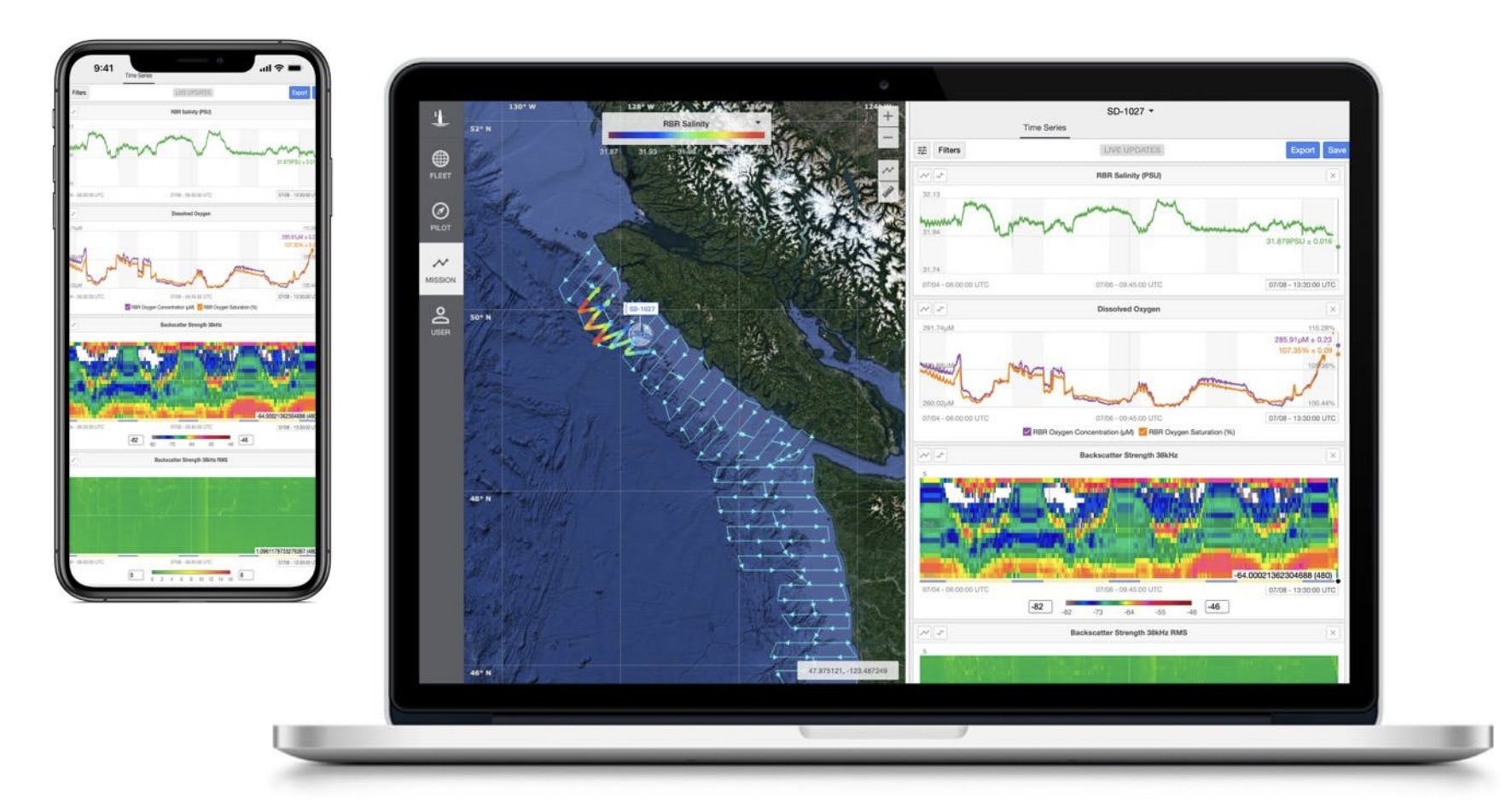
Source: Saildrone
In terms of data types, Saildrone provides high-resolution ocean observation datasets across a range of environmental variables, all scientifically validated and delivered in NetCDF-compliant formats. The company’s data chain is meant to ensure integrity from raw observations through final delivery, supported by CF-compliant metadata, rigorous at-sea validation, and multiple years of comparative testing against established scientific standards. The platform accommodates a flexible sensor suite covering metocean measurements, multibeam bathymetry, radar/AIS-enabled maritime domain awareness, and acoustic monitoring, which are deployable across defense, science, and commercial applications.
Maritime Security
In 2013, the US Navy announced its National Maritime Domain Awareness Plan (MDA) to bolster maritime domain awareness through increased data. Saildrone’s autonomous fleet technology enables it to address security threats posed by a lack of maritime information without the added complexity of enlisting human operators. Customers from the DoD can deploy fleets of drones that can navigate, execute a mission, and collect information without ever leaving the shore.
Saildrone improves maritime domain awareness by detecting targets that pass within the range of sensors. On the surface, a series of radars and cameras are mounted around the Saildrone track for enemy assets. Below the surface, an additional set of sensors tracks objects from the ocean surface to the sea floor.
In 2022, the defense innovation unit partnered with Saildrone to meet its ongoing goal of collecting global maritime intelligence. This partnership was driven by the historically costly nature of manned crews and large quantities of fossil fuels. Saildrone’s vessels directly solve these problems with high-endurance, autonomous vehicles.
Ocean Mapping
Saildrone grants access to unreachable parts of the ocean otherwise inhospitable to humans. Its wing technology was tested under extreme conditions like hurricanes and the Arctic. In both environments, the vessel successfully withstood conditions while preserving high-resolution maps of the sea floor.
The vessel profiles the seafloor with a large multi-beam sonar below the vessel that emits low-frequency sonar waves to the sea floor. These waves bounce off the land and return a response to the sensor, which is then used to create a high-resolution digital twin of the sea floor.
Between 2022 and 2023, Saildrone deployed a long-term survey mission around the Aleutian Islands off the coast of California to map the ocean floor. The mission was designed for autonomous sample collection and ocean mapping. After 52 days, over 4.7K square nautical miles of unexplored land were covered; about the size of Hawaii. Collaborators could follow the data collection in real-time at each mission stage.
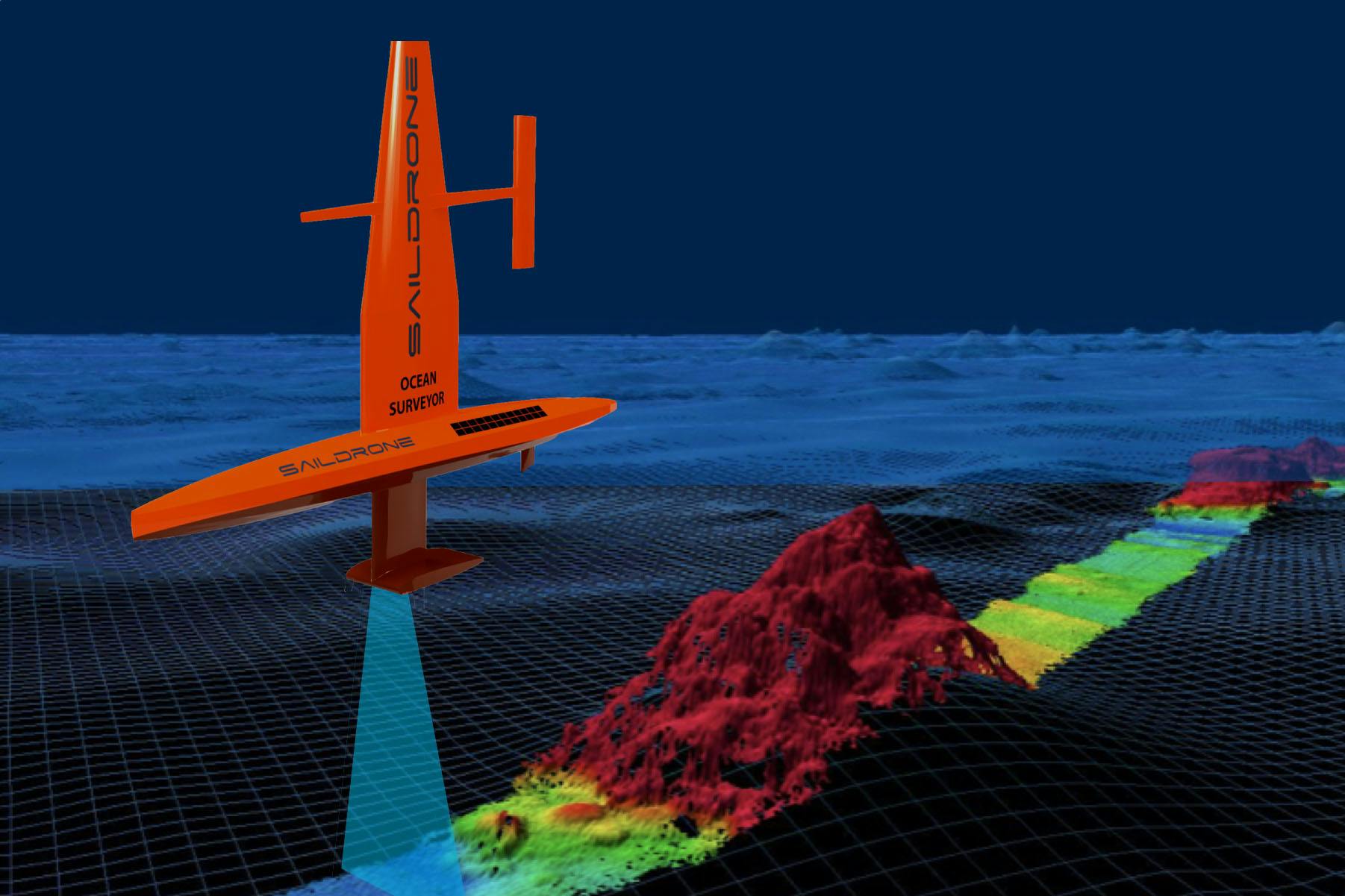
Source: Saildrone
Ocean Research
Data can also provide answers to unexplained phenomena on Earth, like extreme weather patterns. Data collected from unreachable areas on Earth, like the center of a category four hurricane, is used to inform meteorological and oceanographic research. In 2021, a Saildrone traveled to the center of Hurricane Sam, a category four hurricane, where it stayed for over 24 hours to collect data. This information is then stored across various datasets.
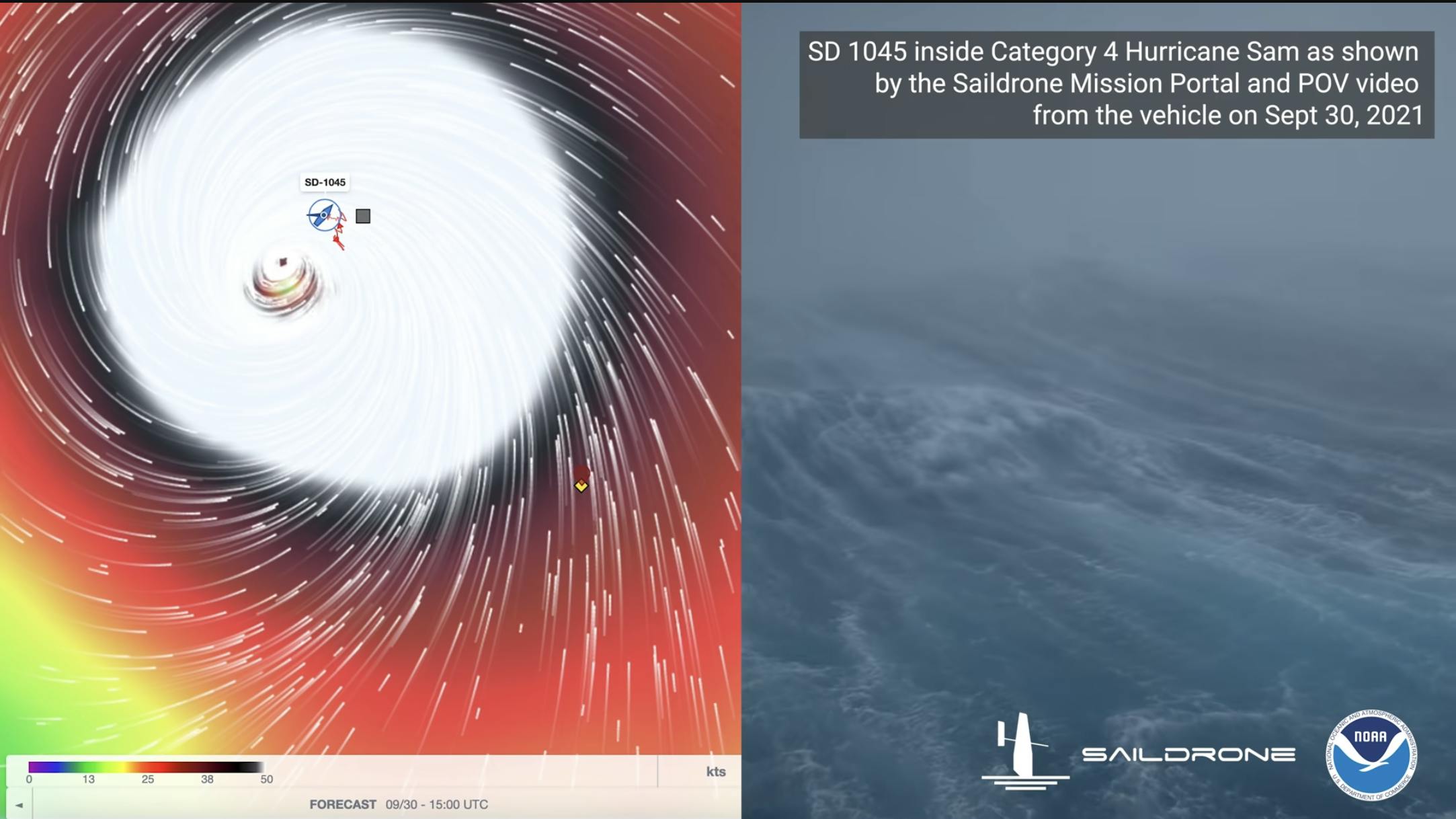
Source: Saildrone
The metocean dataset is a collection of atmospheric metrics, sea surface temperatures, and air-sea flux information used to evaluate climate models and make more precise weather predictions. The fisheries dataset gives patterns of marine mammal movement and locates large fish populations. This helps fisheries get a more precise estimate of stocks and gives local government officials more visibility over illegal fishing practices. Finally, the CO2 monitoring dataset stores data on carbon emissions in the atmosphere and ocean service based on the ASVCO2 sensor systems integrated into the vessel.
Market
Customer
Saildrone is selling its services to any agency that needs to collect ocean data, either for academic research, corporate purposes, or to bolster national security efforts.
Saildrone has partnered with government agencies like the Navy to deploy USVs for maritime domain awareness missions. In December 2023, the Voyager received light warship classification under the American Bureau of Shipping’s light warship code, passing the required safety inspections. This means that Saildrone can legally operate in shipping ports that would be otherwise classified. Collaborating with ports like ABS opens up opportunities to work with commercial partners to automate shipping processes. In September 2023, the Navy deployed ten Voyagers to support Operation Windward Stack, a project used to experiment with hybrid fleets of manned and unmanned vessels.
Saildrone also partners with research institutions like the National Oceanic and Atmospheric Administration (NOAA), which uses the vessels to collect oceanic data. Together, they host annual hurricane missions to collect data to better understand interactions in oceanic atmospheres and improve hurricane prediction models. In 2024, NOAA and Saildrone completed their fourth annual Hurricane Mission, where they successfully collected 768 days of data over 27K nautical miles. Originally, the mission was designed primarily for research. However, organizations under the NOAA, like the National Hurricane Center and National Weather Service, became interested in repurposing the data for weather forecasting purposes.
Partnerships with fisheries and law enforcement turn the vessels into a tool for tracking illegal, unreported, and unregulated fishing (IUU). In 2022, the US Geological Survey contracted Saildrone to collect data from Lake Superior to track $7 billion worth of fisheries in the Great Lakes. This is one of the many efforts they have launched with non-profit and federal partners to advance fishery research approaches.
Market Size
In 2023, the USV market was valued at $2.2 billion, with a projected growth to $3.3 billion in 2032 and a 4.7% CAGR. The market is segmented into national security, scientific research, and commercial.
The maritime information market is valued at $2.8 billion in 2024 and is projected to grow to $3.97 billion in 2029 with a 7.31% CAGR. Another domain Saildrone is targeting is national security and surveillance. As of 2024, the maritime surveillance market is valued higher than the information market at $26.3 billion in 2024, with a projected growth to $40.3 billion by 2029 at a 7.4% CAGR.
Increased threats to U.S. border security, like cybersecurity breaches from seafaring threats, have prompted the government to take direct action to retake control over maritime infrastructure. For example, in 2024, the Biden administration launched an executive order that expanded cyber incident reporting requirements in the maritime domain and investments in critical infrastructure. The DoD has launched similar efforts, such as investing heavily in autonomous maritime systems. In 2023, the US Navy allocated $579 million to developing USVs. Government interest in maritime domain awareness has expanded efforts to adopt technology to support this.
Communication has been a major blocker in the development of USV technology. Water acts as a natural interference mechanism that disperses acoustic waves and makes it difficult to communicate with vessels after they are deployed to the seas. Recently, companies have been investing in improving these systems. For example, in 2023, the US Navy launched its Ghost Fleet Overlord program, which completed a long-range autonomous transit from California to Yokosuka, Japan, built on more reliable communication networks. Demonstrations like these are improving the reliability of USVs and their potential to operate effectively in defense and commercial applications.
Competition
Competitive Landscape
A common trend among alternative USV companies is the movement toward global expansion of ASV and USV technology beyond US borders. Asian-Pacific countries like China, Japan, and South Korea are investing more in developing autonomous vessels, with a projected USV market size in the region expected to reach $879.5 million by 2030. While this is lower than the United States, the CAGR is significantly higher at 15.5% between 2023 and 2030 compared to the United States at 4.7%. USV companies like Maritime Robotics have introduced more foreign investment partners, like NRP Zero from Norway.
In terms of differentiation, Saildrone is unique in the way it's seeking to offer a vertically integrated solution. Despite the market’s expansion, over 70% of maritime vessel companies only build hardware components. Saildrone builds both hardware and software systems that enable operators to look at data throughout the entire mission. This focus on extracting large volumes of data is what Jenkins describes as the main value proposition of the company.
Competitors
Liquid Robotics: Founded in 2007, Liquid Robotics had raised $81.6 million as of June 2025, including a $45 million Series E round in 2013 led by Riverwood Capital. Liquid Robotics developed the Wave Glider, an autonomous wave and solar-powered USV used for ocean observation and surveillance. It’s designed to sustain long missions with over 2.7 million nautical miles traveled in uninhabitable weather, which is crucial for defense and ocean mapping missions. It does this by converting wave motion into energy using a submerged glider connected to a tether. This reduces the deployment time of the vessel. It also uses a versatile communication system through satellite, cell, Wi-Fi, and radio. Information is integrated into its Wave Glider Management System (WGMS), giving the user full access to the data upon collection.
In September 2016, Boeing acquired the company to advance maritime surveillance by leveraging unmanned systems for seafloor communication and anti-submarine warfare. In October 2016, after the acquisition, Liquid Robotics performed a demonstration at the Unmanned Warrior Event hosted by the Royal British Navy, where a network of USVs successfully detected, reported, and tracked a live submarine without human intervention.
Maritime Robotics: Founded in 2005, Maritime Robotics is a Norwegian company focused on building autonomous maritime surveillance systems that power ASVs and USVs. As of June 2025, the company had raised $12 million in funding from investors like the Nordic cleantech fund NRP Zero and the Norwegian state-owned Nysnø Climate Investment.
Its main product is The Otter, a compact, 62 kg USV designed for ocean monitoring, surveillance, and high-quality data collection in shallow regions. The USV has advanced sensors that collect and display data autonomously on a dashboard. The payload integration system handles additional sensor technology that the client adds, making the vessel more versatile for various missions. The Autonomous Navigation System enables operators to interact with the vessel remotely and adjust based on real-time sensor data fed back via communication links. In 2024, Maritime Robotics partnered with Ovun to power sustainable and eco-friendly manufacturing of the Otter’s hulls. The hulls are designed with recycled medium-density polyethylene (MDPE) and with higher durability.
Ocean Infinity: Founded in 2017, Ocean Infinity is a marine robotics company. The company operates two distinctive robotic fleets: the Infinity fleet of 14 autonomous underwater vehicles (AUVs) and the Armada fleet of surface vessels comprised of 23 low-emission, optionally crewed vessels capable of deep-sea operation up to 6 km. Armada ships can deploy AUVs, ROVs, and sensor arrays, remotely controlled from onshore operations centers in Austin and Southampton, with the fleet achieving lower CO₂ compared to conventional survey vessels. By January 2024, Ocean Infinity achieved a regulatory milestone when DNV granted the world’s first Statement of Compliance for remotely supported operations of their 78 m Armada vessels, enabling onshore control of large robotic ships.
Anduril Industries*: Founded in 2017, Anduril is a new-age defense prime building software and hardware platforms across land, air, and sea. Increasingly, the company has expanded its maritime autonomy portfolio, building on its flagship AI infrastructure product, Lattice, to power a family of unmanned surface and underwater vehicles. As Saildrone continues to expand its efforts into military use cases, it could increasingly compete for some contracts with companies like Anduril. Anduril’s products include Dive‑LD and Dive‑XL (also known as Ghost Shark XL‑AUV), which were acquired as Dive Technologies in 2022. These large AUVs operate down to 6 km depth for ISR, mine‑countermeasure, seafloor mapping, and undersea payload delivery. In April 2025, Anduril delivered the first Dive‑LD to the U.S. Navy’s UUVRON‑1 following extensive trials.
In addition to specific vendors, there are also a number of research-oriented ocean data platforms, such as Fugro and XOCEAN, as well as traditional defense primes with budding USV offerings, such as L3Harris.
Business Model
Saildrone makes money from selling the data it collects. It operates on a mission-as-a-service (MAAS) model where it uses USVs to carry out missions and scrape data, which it then analyzes, manages, and displays for the customer. Customers pay based on operational times. Saildrones cost $2.5K per day to operate. This includes deployment, retrieval, packing, transporting, launching, and returning the vehicle; all managed by Saildrone’s mission control team. Customer can enhance data collection capability by adding their own payload sensors. This system also reduces cost, since the vessels can be reused for future missions and be powered by solar energy with no fuel required, making it more cost-effective while minimizing carbon emissions.
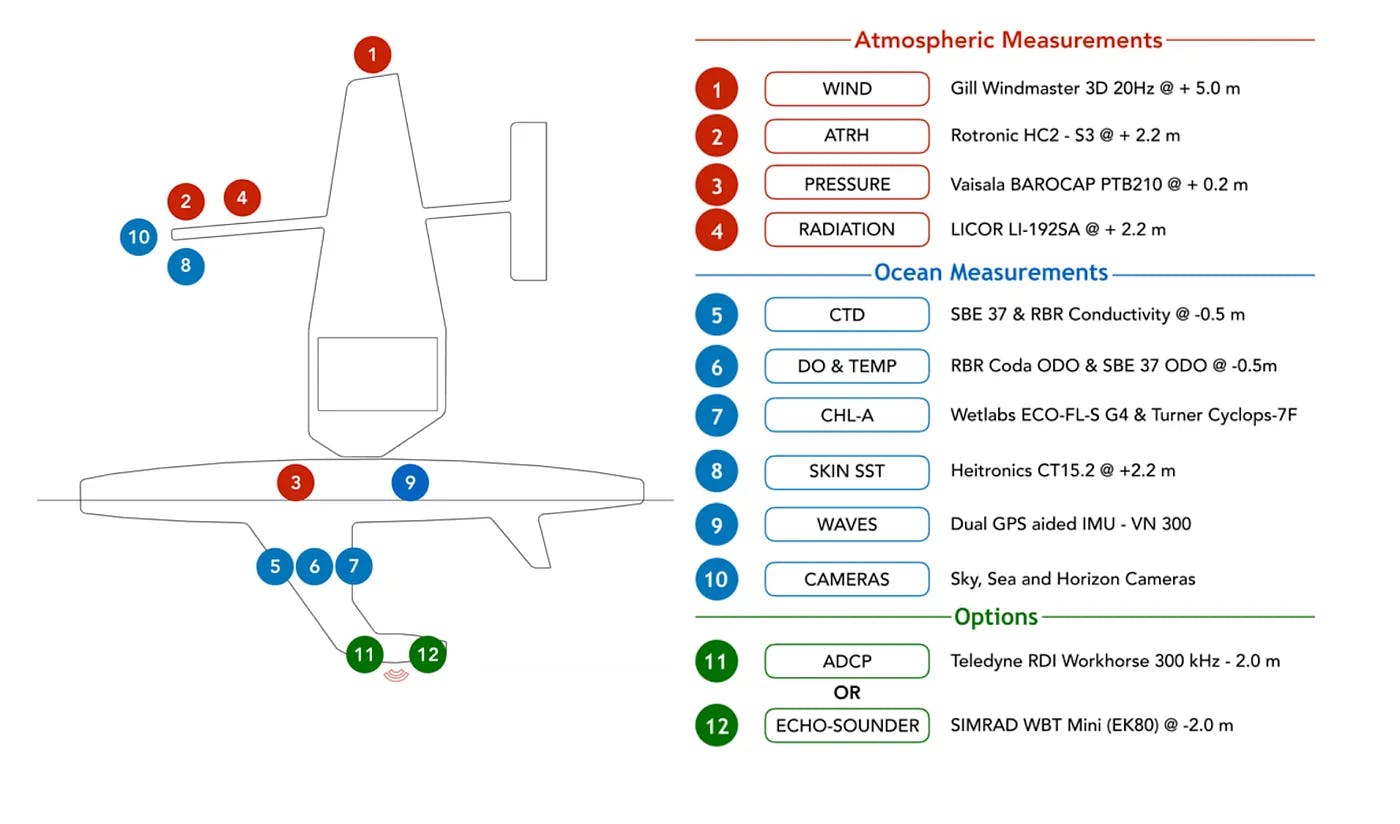
Source: Saildrone
Traction
Saildrone was recognized as TIME’s 100 Most Influential Companies in 2024 following the launch of Surveyor and the release of its Carbon Impact Report, which showed that Saildrones reduced 99% of carbon emissions compared to traditional vessels. In 2024, the Surveyor autonomous vessel was deployed for Navy testing. Currently, sail drones are used to gather military intelligence from the seas and have not been used for offensive roles yet. In addition, Saildrone’s fleet reached 1 million cumulative nautical miles sailed in 2024. One unverified estimate indicated Saildrone’s revenue was at $43 million in 2024, growing 231%.
Valuation
In 2012, Saildrone received its first grant from Jenkins’s close friend and Google Executive Eric Schmidt and his wife Wendy, who ran the Schmidt Family Foundation. In 2016, it received a $14 million Series A led by Social Capital with investments from Capricorn Investment Group and Lux Capital. In 2017, it received its first $3 million loan from the Silicon Valley Bank to support its capital-intensive goals. In 2021, Saildrone raised a $100 million Series C with a post-money valuation of over $500 million led by BOND. Other investors included Lux Capital and Tribe Capital.
In May 2025, Saildrone raised $60 million in funding from EIFO, the Export and Investment Fund of Denmark, with a focus on expanding its efforts in Europe. Later, in June 2025, the company announced the launch of four Voyager USVs in Danish waters.
Key Opportunities
Increased Data Demand Globally
The demand for ocean data globally has rapidly increased for both academic and military purposes. For example, Seabed 2030 was formally endorsed by the United Nations to unite resources to map 100% of the seafloor by 2030. In April 2023, Saildrone formally partnered with the program to leverage USV to increase global understanding of the seafloor. As these efforts become more common, Saildrone’s existing fleet will position it to be an ideal partner.
One example of this is Saildrone’s partnership with Meta. In June and July 2024, Saildrone and Meta completed the first autonomous deep-water cable route survey in the North Atlantic using the 20-meter Saildrone Surveyor. Over a 26-day mission, the uncrewed vessel mapped more than 4.5K km of seabed up to 5.5K meters deep using advanced sonar while matching the performance of traditional crewed surveys across key metrics like data accuracy, line keeping, and route fidelity.
Government Collaboration
Saildrone has already established several partnerships with the NOAA by collaborating on several years of missions to survey hurricanes. In terms of military collaborations, Saildrone has also partnered with the US Navy and has been deployed in several unmanned operations. Saildrone has also been used for provincial justice systems for unregulated fishing, law enforcement, maritime safety, drug interdiction, and border and harbor security. Several government certifications, like the Approval in Principle (AIP) from the American Bureau of Shipping (ABS) to commercialize the Voyager and Surveyor USVs. Going forward, the company has the ability to more extensively expand its work both with federal and regional agencies, as well as international allies.
Key Risks
Regulatory Challenges
There are complex regulatory requirements that govern maritime operations around sustainability and deployment. Involvement in maritime surveillance and expansion introduces international regulations. Coastal and EEZ jurisdictions may impose restrictions on foreign-operated or autonomous vessels conducting surveys, surveillance, or environmental monitoring. In addition, for data used for defense-related applications or shared with foreign entities, U.S. International Traffic in Arms Regulations (ITAR) or Export Administration Regulations (EAR) impose controls over specific data usage.
Beyond specific government regulation, general government bureaucracy makes the integration of new technologies even more time-consuming due to regulatory frameworks. This could clash with operational timelines and affect deployment dates, crucial for ocean operations that require planning ahead. It can cause stagnation and limit the R&D process for new features or improvements. Legal ambiguity with autonomous maritime vehicles across different jurisdictions poses more challenges to expansion.
Technological Obsolescence
As of 2024, ocean-based technology is rapidly progressing. Improved battery life, AI capability, and sensor technology make it difficult for a single product offering to survive without quickly integrating new capabilities. In 2022, Hydroid, which was acquired by Huntington Ingalls Industries in 2020, introduced Odyssey, a suite of autonomous integrations that can turn any ship or vessel into an AUV. This is more versatile than a single suite of vessels, which could pose a threat to Saildrone’s business.
Summary
The ocean is one of the most information-dense yet unexplored areas of the Earth. The ability to take advantage of that vast amount of information creates meaningful access to information that can drive scientific progress and maintain national interests. Saildrone’s mission is to leverage autonomy to gain full access to the ocean that was historically inaccessible to humans. Its sea drones are built on decades of engineering and analysis models that don't just collect data but make sense of it to better understand the ocean. Going forward, the company will seek to take advantage of increased demand for ocean-based data while working to maintain technical leadership and maneuvering government regulation.
*Contrary is an investor in Anduril through one or more affiliates.
